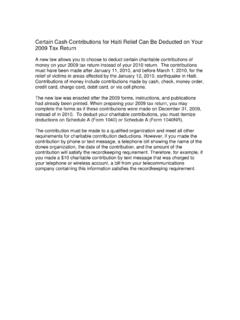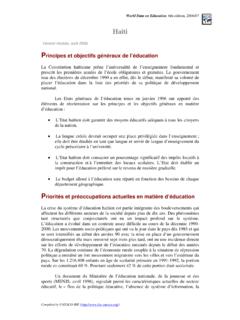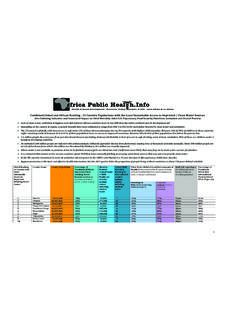Transcription of Background on Haiti & Haitian Health Culture
1 A Cultural Competence Primer from Cook Ross Inc. Background on Haiti & Haitian Health Culture History & Population Concept of Health Beliefs, Religion & Spirituality . Language & Communication Family Traditions Gender Roles . Diet & Nutrition Health Promotion/Disease Prevention Illness-Related Issues . Treatment Issues Labor, Birth & After Care Death & Dying THIS PRIMER IS BEING SHARED PUBLICLY IN THE HOPE THAT. IT WILL PROVIDE INFORMATION THAT WILL POSITIVELY IMPACT. 2010 POST-EARTHQUAKE HUMANITARIAN RELIEF EFFORTS IN Haiti . DISCLAIMER. Although the information contained in applies generally to groups, it is not intended to infer that these are beliefs and practices of all individuals within the group. This information is intended to be used as a basis for further exploration, not generalizations or stereotyping.
2 COPYRIGHT. Reproduction or redistribution without giving credit of authorship to Cook Ross Inc. is illegal and is prohibited without the express written permission of Cook Ross Inc. FOR MORE INFORMATION. Contact Cook Ross Inc. phone: 301-565-4035 website: Background on Haiti & Haitian Health Culture Table of Contents Chapter 1: History & Population 3. Chapter 2: Concept of Health 6. Chapter 3: Beliefs, Religion & Spirituality 9. Chapter 4: Language & Communication 16. Chapter 5: Family Traditions 23. Chapter 6: Gender Roles 29. Chapter 7: Diet & Nutrition 30. Chapter 8: Health Promotion/Disease Prevention 35. Chapter 9: Illness-Related Issues 39. Chapter 10: Treatment Issues 57. Chapter 11: Labor, Birth & After Care 67. Chapter 12: Death & Dying 72. About CultureVision While Health care is a universal concept which exists in every cultural group, different cultures vary in the ways in which Health and illness are perceived and how care is given.
3 Culture is a predominate force in shaping behaviors, values, and beliefs that impact an individual's Health and response to illness. CultureVision is a web-based knowledge-management tool available by subscription. CultureVision helps providers know what sorts of questions to ask in order to tailor treatments to effectively treat patients in comport with their values and cultural framework. For more information, visit: About Cook Ross Inc. Cook Ross Inc. is a nationally recognized, certified woman-owned consulting firm. We increase profit, performance and collaboration by transforming organizational cultures, strengthening leadership, and leveraging diversity, inclusion & cultural competency. Visit us online for information and free publications at: 2010 Cook Ross Inc. This information is intended to be used as a basis for further exploration 2.
4 Rather than generalizations or stereotyping. Chapter 1: Haiti History and Population Haiti is an island nation located between the Caribbean Sea and the Atlantic Ocean. It occupies the western third of the island of Hispaniola; the Dominican Republic occupies the eastern two-thirds. The Arawak and Taino were the indigenous peoples inhabiting Hispaniola prior to 1492, the year that Christopher Columbus arrived on the island. He quickly established a Spanish colony and enslaved the original inhabitants. Within a short time, most of the Arawak and Taino population had been decimated by starvation, harsh treatment, European diseases against which they had no immunity or some combination of these factors. Beginning in 1517, the Spanish began to import large numbers of African slaves to replace indigenous labor in the gold mines and sugar plantations.
5 In 1697, Spain gave the western portion of Hispaniola to France with the remainder handed over in 1795. There were a number of slave revolts in colonial times but none was successful until that organized in 1798 by Toussaint L'Ouverture, a freed slave. L'Ouverture was later captured and imprisoned where he died. His death did not quench the slaves' desire for freedom, however, and in 1804, Jean-Jacques Dessalines was successful in establishing Haiti as the first, independent Black republic. Dessalines was named emperor but lived only two years in that role; his death was followed by a long period of instability, frequent regime change and, at times, near anarchy. In 1915, the US invoked the Monroe Doctrine and invaded Haiti ; this occupation lasted until 1934. Despite the presence of US troops, political coups and economic chaos continued.
6 Francois ( Papa Doc ) Duvalier, supported by the US, became president in 1957. He maintained political and social control through the Tonton Macoutes , a notorious secret police force which effectively terrorized the population through killings and disappearances. In 1971, Duvalier named his son, Jean-Claude (also known as Baby Doc) as his successor. By 1986, Baby Doc was forced to leave Haiti following widespread protests and riots. After four years of military rule, Jean-Bertrand Aristide, a former Catholic priest, was democratically elected president in 1990. His short tenure was plagued by conflict between his supporters and critics and eight months later, he was exiled to the US and succeeded by General Raoul Cedras. Cedras launched a brutal campaign of suppression and killings of Aristide' supporters; after several years of trade embargos, the US invaded in 1994 and overthrew Cedras's military regime.
7 Aristide resumed the presidency for 10 years until he was again overthrown in 2004. 2010 Cook Ross Inc. This information is intended to be used as a basis for further exploration 3. rather than generalizations or stereotyping. The constant political strife, economic chaos and a series of natural disasters, including two hurricanes in 2008, have taken an enormous toll on the Haitian people. The majority live an impoverished life (on roughly $1 US per day). Recently, the rising cost of food and fuel have become a crisis in Haiti ; protests against the price of basic staples are common. Some have resorted to desperate measures eating clay cookies of edible dirt to survive (Katz 2008). Immigration waves and settlement trends (Unaeze and Perrin 2000). Haitian emigration waves are often prompted by regime change as well as heightened discord within the country.
8 Some of these waves include: Many of Haiti 's affluent population as well as some slaves left in the 1790s following revolts that ended slavery and won independence for Haiti . o They settled in France (most of the educated and affluent) and the US in Louisiana, Virginia, Maryland, New York and Massachusetts. During the US occupation in Haiti (1915-1934). During the reign of the Duvaliers (Papa Doc and Baby Doc) (1957-1986). o Many of Haiti 's students and professionals left at this time. o They resettled in the US, as well as in Mexico, Puerto Rico, Jamaica, France, Dominican Republic, French Guyana, and parts of Africa. Upheaval of Aristide in 1991. Some refer to Haitian emigrants who left during the 1980s and 1990s, as well as more recently, as boat people due to the fact that many of them arrived in Florida on boats.
9 Many perished on the journey, others were turned away or not rescued at sea and many were detained before being granted entrance into the US. This treatment of Haitian immigrants is a major topic of discussion within and outside the Haitian community. In the late 1970's, a large proportion of Haitian immigrants settled in Brooklyn, New York while later waves settled primarily in Florida. Some reports indicate that 1 out of 8 Haitians live outside of Haiti (LOCHA 2006) while others estimate that the number is closer to 50% or 1 in 2. (Lauredan and Leiderman 2007). More than 2 million people of Haitian descent live in the US. (Lauredan and Leiderman 2007). Many of these immigrants are skilled professionals (doctors, lawyers, educators, nurses, etc.), which has depleted Haiti of the types of workers that it needs (LOCHA 2006).
10 The largest Haitian communities in the US reside in (Lauredan and Leiderman 2007): New York (800,000+). Florida (700,000+). New Jersey (150,000+). Massachusetts (100,000+). Connecticut (50,000+). 2010 Cook Ross Inc. This information is intended to be used as a basis for further exploration 4. rather than generalizations or stereotyping. Pennsylvania (30,000+), Illinois (100,000+). Georgia (50,000+). While earlier waves of Haitian immigrants were educated and skilled professionals, later waves included people from all levels of Haitian society including the uneducated and illiterate. Most Haitians are proud of their heritage and prefer to be distinguished as such. Often, Haitians self identify as Black , particularly younger, American born people of Haitian descent. It is common for Haitians to be included in the Black/African American demographic in national statistical data and reports.












